During the COVID-19 lockdown, individuals were asked to leave their homes only for essential needs like grocery shopping. The safety of grocery stores became a top concern for shoppers. Are grocery stores safe? Let’s explore the health and safety measures implemented by grocery stores to ensure a secure shopping experience.
Table of Contents
Key Takeaways:
- Grocery stores have implemented various health and safety measures during the COVID-19 pandemic.
- These measures include social distancing, enhanced sanitation protocols, and contactless shopping options.
- Curbside pickup and online grocery shopping are convenient alternatives to minimize contact in-store.
- Shoppers should follow guidelines and adopt healthy habits while grocery shopping.
- Working together, grocery stores and customers can create a safe and secure shopping environment.
The Impact of COVID-19 on Grocery Shopping Behavior
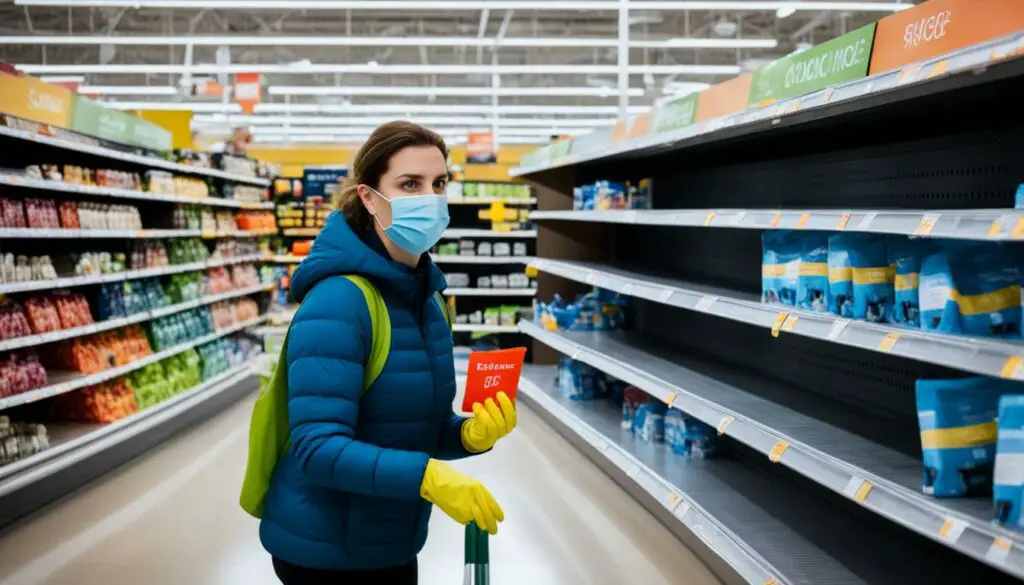
The COVID-19 pandemic has had a profound impact on the way people shop for groceries. With restrictions in place and concerns about safety, individuals have made significant changes to their grocery shopping behavior.
One of the notable changes is the reduction in the frequency of grocery shopping trips. People have started to consolidate their shopping needs and make fewer visits to the store. This change can be attributed to a desire to minimize exposure to crowded places and reduce the risk of contracting the virus.
Moreover, individuals tend to shop quickly and efficiently when they do go to the grocery store. The fear of exposure has prompted shoppers to plan their shopping list in advance, making sure to get everything they need in one visit. This behavior not only saves time but also reduces the potential for unnecessary exposure.
Another noticeable shift is the increase in the purchase of packaged foods. As people strive to limit their grocery store visits, they tend to buy more packaged items that have a longer shelf life. This change in preference reflects the desire for convenience and the need to stock up on essentials.
“The COVID-19 pandemic has significantly impacted the frequency and manner in which consumers shop for groceries. As people navigate through this challenging time, their shopping behavior has evolved to prioritize safety and efficiency.”
Furthermore, individuals have also shown an increased willingness to try new brands. With limited options on the shelves and a growing interest in exploring new alternatives, shoppers have embraced the opportunity to experiment and discover different products.
The adoption of healthier food habits during the pandemic has been mixed. While some individuals have taken this time as an opportunity to focus on their well-being and incorporate healthier foods into their diets, others have faced challenges due to limited availability or financial constraints.
Changes in Grocery Shopping Behavior:
| Changes | Description |
|---|---|
| Reduction in frequency | People are making fewer trips to the grocery store, consolidating their shopping needs. |
| Efficient shopping | Shoppers plan their visits in advance, ensuring they get everything they need in one trip. |
| Increase in packaged foods | The preference for packaged items has grown as people aim to minimize outings and stock up on essentials. |
| Willingness to try new brands | Consumers have embraced the opportunity to explore new alternatives amid limited options. |
The impact of COVID-19 on grocery shopping behavior is expected to have lasting effects even beyond the pandemic. As individuals adapt to new habits and explore alternative ways to meet their grocery needs, the industry continues to evolve to address changing consumer preferences.
Consumer Concerns about Grocery Shopping

As the COVID-19 pandemic continues, consumers have expressed various concerns regarding grocery shopping. These concerns revolve around two main fears: the fear of unavailability of stocks and the fear of getting infected from grocery storekeepers.
Fear of Unavailability of Stocks
One of the primary worries shoppers have is the fear of not finding the essential items they need. The uncertainty surrounding stock availability, especially for high-demand products like cleaning supplies, toilet paper, and certain food items, has caused anxiety among consumers.
Customers want to be confident that they will find the items they require during their shopping trips, ensuring they can adequately provide for themselves and their families. The fear of not being able to access essential goods has driven changes in purchasing behaviors, with some individuals reducing the frequency of their grocery shopping trips and purchasing larger quantities to stock up.
Fear of Getting Infected from Grocery Storekeepers
Another significant concern for shoppers is the fear of getting infected from grocery storekeepers. Consumers want reassurance that the necessary precautions are being taken to ensure their safety while shopping.
COVID-19 is primarily transmitted through close contact with infected individuals. Shoppers are wary of physical proximity to store employees and are concerned about the potential risk of contracting the virus while interacting with them at checkout counters or when seeking assistance.
“I worry about the grocery store workers. Are they getting infected? Are they following all the necessary safety protocols? I want to know they are doing everything they can to keep shoppers like me safe.”
Grocery stores must address these concerns by implementing stringent health and safety measures, including proper sanitation practices, mandatory mask usage, and ensuring physical distancing between shoppers and store staff.
To alleviate these concerns, it is crucial for stores to communicate their safety protocols to customers effectively. Transparency and clear communication build trust and confidence in shoppers, encouraging them to feel safe while conducting their grocery shopping.
- Implementing risk mitigation strategies such as enhanced cleaning and disinfection practices
- Requiring store employees to wear personal protective equipment (PPE) like masks and gloves
- Enforcing physical distancing measures through floor markings and limited store capacity
- Providing hand sanitizing stations throughout the store
By prioritizing the implementation of these safety measures and actively addressing consumer concerns, grocery stores can create a shopping environment that puts the well-being of their customers first.
Importance of Health and Safety Practices in Grocery Stores
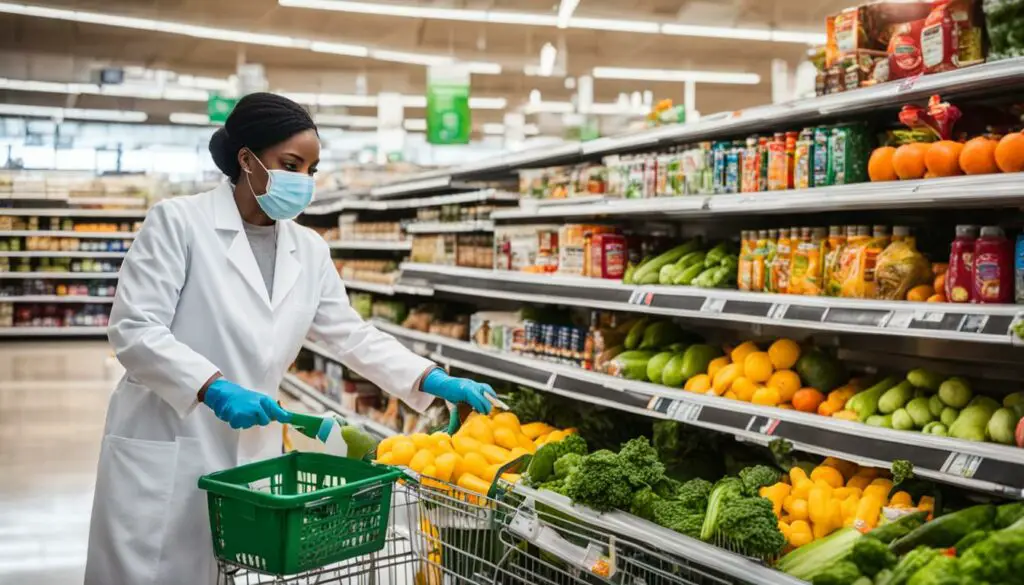
When it comes to grocery stores, health and safety practices are of utmost importance, especially during the ongoing COVID-19 pandemic. These practices not only protect the well-being of customers but also create a safe environment for store staff. Let’s take a closer look at some key measures that grocery stores should implement:
Physical Distancing between Shoppers
Grocery stores should encourage and enforce physical distancing among shoppers to minimize the risk of transmission. This can be achieved by placing floor markings to indicate proper distancing, limiting the number of shoppers allowed inside the store at a time, and creating one-way aisles to maintain a safe flow of traffic.
Hand Sanitizing Stations
Providing hand sanitizing stations throughout the store is essential to promote good hygiene practices. Customers should have easy access to hand sanitizers to clean their hands before and after shopping. These stations should be strategically placed in high-traffic areas, such as entrances, exits, and near checkout counters.
Cleaning and Disinfection of High-Touch Surfaces
Grocery stores must prioritize regular cleaning and disinfection of high-touch surfaces to prevent the spread of germs and viruses. This includes shopping carts, baskets, checkout counters, self-checkout machines, and any other surfaces frequently touched by customers. Diligent cleaning practices help ensure a hygienic shopping environment.
Hygiene Practices for Store Staff and Customers
Both store staff and customers should follow proper hygiene practices to reduce the risk of infection. This includes wearing masks or face coverings, practicing good hand hygiene, and maintaining overall cleanliness. By adhering to these practices, everyone contributes to maintaining a safe and healthy shopping experience.
Comparison of Health and Safety Practices in Grocery Stores
| Health and Safety Practices | Importance |
|---|---|
| Physical Distancing | Minimizes the risk of transmission |
| Hand Sanitizing Stations | Promotes good hygiene practices |
| Cleaning and Disinfection | Prevents the spread of germs and viruses |
| Hygiene Practices for Store Staff and Customers | Reduces the risk of infection |
Implementing these health and safety practices in grocery stores is essential to protect the well-being of both customers and staff members. By adhering to physical distancing guidelines, providing hand sanitizing stations, prioritizing cleaning and disinfection, and promoting good hygiene practices, grocery stores can create a safe environment for everyone.
The Role of Online Grocery Shopping in Ensuring Safety
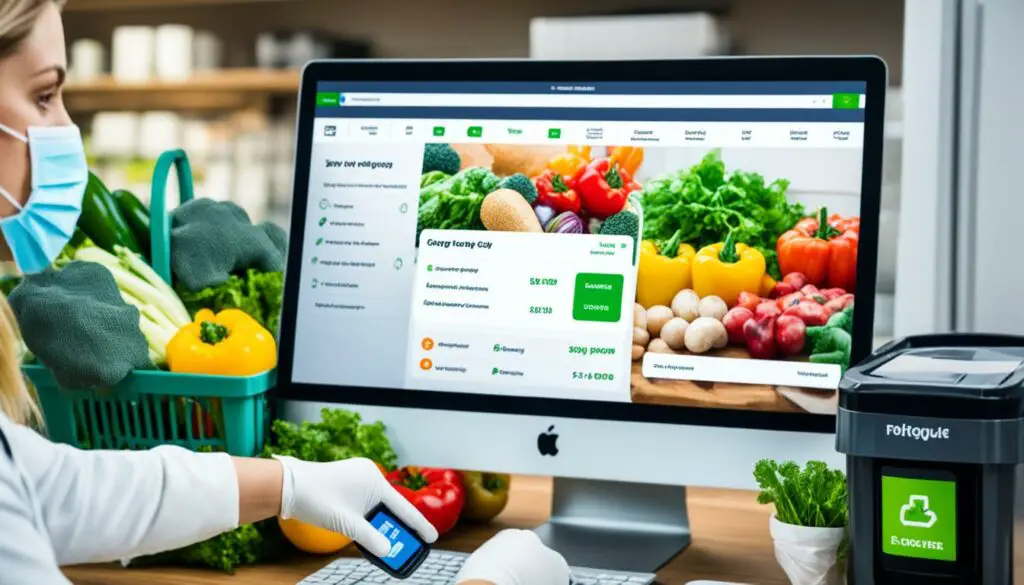
During the COVID-19 pandemic, online grocery shopping has become a popular and reliable way for consumers to meet their essential needs while minimizing direct contact in crowded spaces. By offering contactless shopping options and curbside pickup services, grocery stores have implemented safety measures to protect both their customers and staff.
Online grocery shopping provides a convenient and efficient way to purchase essential items without the need to physically enter a store. With just a few clicks, customers can browse through a wide range of products, select the items they need, and have them delivered straight to their doorstep.
For those who prefer to avoid delivery services, many grocery stores now offer curbside pickup. Customers can order their groceries online and schedule a pickup time. Upon arrival, they can remain in their vehicles while store staff brings out their orders, minimizing direct contact and maintaining social distancing protocols.
These contactless shopping options not only ensure the safety of customers but also protect the health of store staff who handle the orders. By reducing the need for physical interaction, the risk of transmission of COVID-19 is significantly decreased.
In addition to contactless shopping, online grocery shopping also enables customers to adhere to other recommended safety measures. They can easily access information about product availability, compare prices, and read reviews from other shoppers, all from the comfort of their homes. This reduces the need for unnecessary trips to different stores, helping to minimize exposure to crowded environments.
Furthermore, online platforms often provide detailed information about the safety measures taken by the grocery stores they partner with. Customers can learn about sanitation protocols, hygiene practices, and other safety measures implemented to ensure a safe shopping experience.
By leveraging the benefits of online grocery shopping, consumers can protect themselves and others while still obtaining the essential items they need. These safety measures have made online grocery shopping an invaluable tool during these challenging times, promoting health and well-being for all.
Sanitation Protocols in Grocery Stores
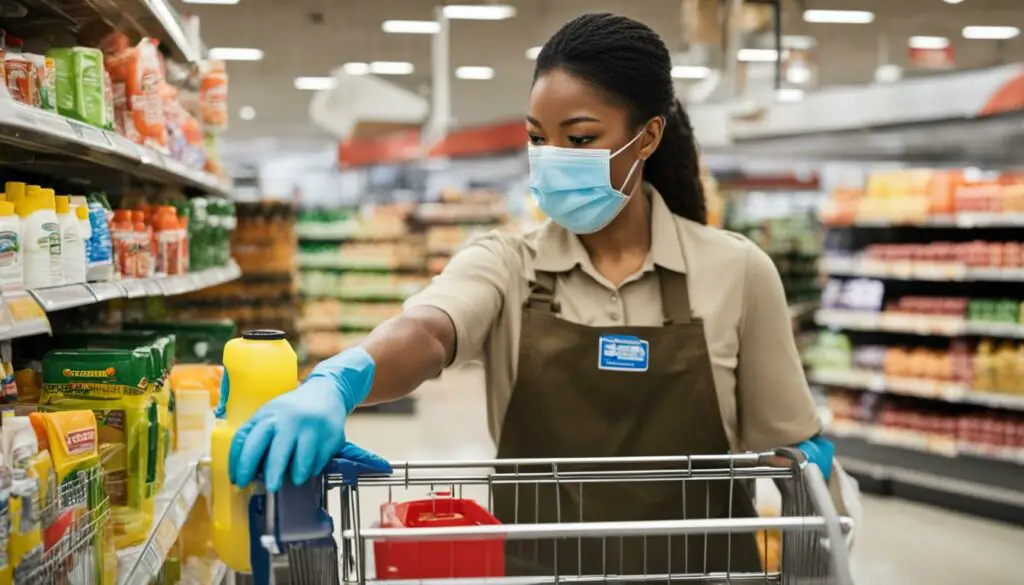
Grocery stores have implemented strict sanitation protocols to minimize the risk of infection. These protocols are crucial in creating a safe and hygienic shopping environment for customers. Key measures include:
-
Regular cleaning and disinfection of high-touch surfaces such as:
- Shopping carts
- Baskets
- Checkout counters
- Self-checkout machines
- Providing sanitizing stations for customers to clean their hands before and after shopping. These stations are conveniently located throughout the store to promote hand hygiene.
By prioritizing the cleaning and disinfection of high-touch surfaces, grocery stores significantly reduce the potential transmission of viruses and bacteria. Regular sanitization helps maintain a safe shopping environment for all customers and staff.
“Sanitization of high-touch surfaces plays a critical role in preventing the spread of infectious diseases. Grocery stores have taken proactive steps to ensure the safety and well-being of their customers by implementing rigorous cleaning protocols.”
Effective sanitation practices reassure customers that their health and safety are of utmost importance.
| High-Touch Surfaces | Cleaning Frequency | Disinfection Frequency |
|---|---|---|
| Shopping carts | Daily | After every use |
| Baskets | Daily | After every use |
| Checkout counters | Hourly | Hourly |
| Self-checkout machines | Daily | Daily |
The Importance of Social Distancing in Grocery Stores
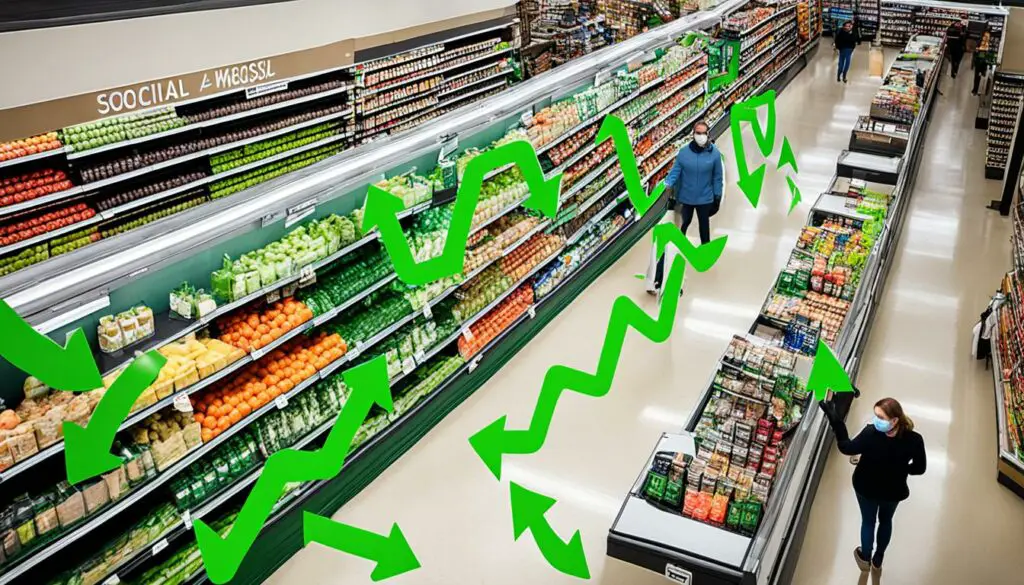
Social distancing is a critical measure to prevent the spread of COVID-19 in grocery stores. By maintaining a safe distance from others, both shoppers and store staff can reduce the risk of infection and create a safer shopping environment. Grocery stores play a crucial role in implementing measures that encourage and enforce social distancing.
Floor Markings and One-Way Aisles
Grocery stores can take several steps to encourage social distancing among shoppers. One effective measure is to use floor markings to indicate the appropriate distance to maintain from others. These markings can be placed at checkout lines, entrance areas, and other high-traffic zones to guide customers and remind them to stay apart.
Additionally, creating one-way aisles can help maintain physical distancing and reduce the chances of close contact between shoppers. By designating specific directions for each aisle, grocery stores can further ensure that customers can navigate the store while maintaining a safe distance from one another.
Limiting Shopper Capacity
Another important measure is to limit the number of shoppers allowed inside the store at a given time. By controlling the store’s capacity, grocery stores can facilitate social distancing by preventing overcrowding and maintaining adequate space between individuals. This approach can offer a more controlled and safer shopping experience for everyone.
Customer Responsibility
While grocery stores play a pivotal role in implementing social distancing measures, it is equally important for customers to adhere to these guidelines. Shoppers should respect and follow the floor markings, maintain a safe distance from others, and avoid unnecessary close interactions. By being conscientious and responsible while shopping, customers can contribute to creating a safer environment for everyone.
Health Measures Adopted by Shoppers
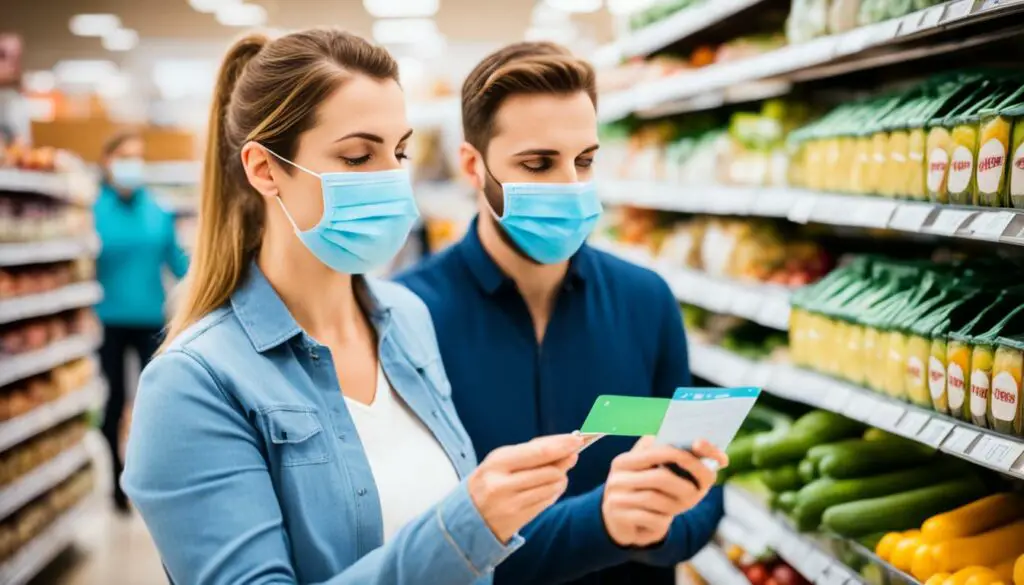
When it comes to grocery shopping during the COVID-19 pandemic, shoppers have a crucial role to play in ensuring their own safety and the safety of others. By following health safety practices, shoppers can contribute to creating a safer and more secure shopping environment for everyone.
Wearing Masks in Grocery Stores
One of the key health measures adopted by shoppers is wearing masks or face coverings. Masks help prevent the spread of respiratory droplets, reducing the risk of transmission of COVID-19. By wearing masks, shoppers demonstrate their commitment to protecting themselves and others while in the grocery store.
Practicing Hand Hygiene
Another important health safety practice is practicing good hand hygiene. Shoppers should wash their hands frequently with soap and water for at least 20 seconds, especially before and after entering the grocery store, touching surfaces, or handling products. Alternatively, using hand sanitizers with at least 60% alcohol content can be an effective way to keep hands clean and free from germs.
Following Store Guidelines and Protocols
Grocery stores have implemented various guidelines and protocols to mitigate the spread of COVID-19. Shoppers should familiarize themselves with these guidelines, such as maintaining physical distance from others, following designated pathways within the store, and limiting the handling of products unless necessary. By adhering to these guidelines, shoppers can contribute to maintaining a safe shopping environment for everyone.
“By wearing masks, practicing good hand hygiene, and following store guidelines, shoppers can contribute to a safer and more secure grocery shopping experience.”
Summary of Health Measures Adopted by Shoppers
| Health Measure | Importance |
|---|---|
| Wearing Masks | Reduces the risk of respiratory droplet transmission |
| Practicing Hand Hygiene | Prevents the spread of germs and viruses |
| Following Store Guidelines | Contributes to maintaining a safe shopping environment |
By adopting these health measures, shoppers can prioritize their own well-being and the well-being of others, creating a safer and more responsible grocery shopping environment amidst the ongoing pandemic.
The Importance of Hygiene Practices in Grocery Stores
Maintaining good hygiene practices in grocery stores is crucial for preventing the spread of COVID-19 and ensuring the safety of both customers and employees. By implementing proper cleanliness and disinfection protocols, grocery stores can create a hygienic shopping environment that instills trust and confidence in shoppers.
One of the key aspects of hygiene practices in grocery stores is regular cleaning and disinfection of commonly touched surfaces. This includes shopping carts, checkout counters, self-checkout machines, and door handles. By disinfecting these high-touch areas frequently, stores can minimize the risk of transmission and provide a clean and safe shopping experience for customers.
Hand sanitizing stations should be readily available throughout the store for both customers and employees. These stations allow individuals to sanitize their hands before and after shopping, reducing the potential spread of germs. Providing easy access to hand sanitizers promotes good hand hygiene and reinforces the importance of cleanliness.
Employees also play a crucial role in maintaining hygiene practices. They should follow proper hand hygiene guidelines, which include washing hands frequently with soap and water for at least 20 seconds. Additionally, employees should wear gloves and masks as required, further enhancing the overall hygiene standards in the store.
“Maintaining good hygiene practices in grocery stores is crucial for preventing the spread of COVID-19 and ensuring the safety of both customers and employees.”
By prioritizing hygiene practices, grocery stores can provide a safe environment for both shoppers and employees. These measures not only reduce the risk of COVID-19 transmission but also promote overall cleanliness and well-being.
| Grocery Store | Cleaning Frequency | Hand Sanitizing Stations | Employee Hygiene |
|---|---|---|---|
| Store A | Every 2 hours | Available at entrances and exits | Masks and gloves worn by all employees |
| Store B | Twice a day | Station near checkout counters | Masks worn by employees |
| Store C | Every 4 hours | Located at various points throughout the store | Frequent handwashing and masks worn by employees |
Implementing effective hygiene practices is essential for grocery stores to maintain a clean and safe shopping environment. By prioritizing cleanliness, regular cleaning, and proper hand hygiene, stores can give shoppers peace of mind and create a positive shopping experience.
The Role of Grocery Stores in Promoting Healthy Eating
The COVID-19 pandemic has brought about a renewed focus on maintaining a healthy lifestyle and adopting healthier food habits. Grocery stores play a crucial role in promoting and facilitating access to nutritious food options, making it easier for customers to make healthier choices.
One of the key ways that grocery stores promote healthy eating is by offering a wide variety of fresh fruits and vegetables. These nutritious options are prominently displayed, making it convenient for shoppers to incorporate them into their diets. From vibrant berries to leafy greens, grocery stores provide an abundance of choices that cater to different tastes and preferences.
In addition to fresh produce, grocery stores also offer an array of whole grains, lean proteins, and other healthy food choices. These items can be found in dedicated aisles or sections, making it easy for customers to identify and select the ingredients they need to create nutritious meals. By providing diverse options, grocery stores empower customers to make informed decisions about the food they consume.
Moreover, grocery stores often collaborate with local farmers and suppliers to source high-quality, nutritious products. This supports the local community and ensures that customers have access to fresh and wholesome options. Additionally, some grocery stores may offer organic or sustainably sourced products, catering to the growing demand for environmentally friendly and health-conscious choices.
By actively promoting healthy eating, grocery stores contribute to the adoption of healthier food habits within the community. They have the ability to influence purchasing decisions by providing educational resources, recipes, and cooking tips that emphasize the importance of nutrition. Through in-store signage and informative displays, grocery stores can inspire customers to make healthier choices while shopping.
Benefits of Grocery Stores’ Role in Promoting Healthy Eating:
- Improved access to nutritious food options
- Supports local farmers and suppliers
- Encourages informed decision-making
- Provides educational resources and cooking tips
- Inspires healthier choices within the community
Overall, grocery stores play a vital role in promoting healthy eating habits and ensuring that customers have access to nutritious food options. By offering a diverse range of fresh produce, whole grains, lean proteins, and other healthy choices, grocery stores empower individuals to adopt healthier food habits and make positive changes in their lives.
Nutritious Food Options Available at Grocery Stores
| Fruit | Vegetables | Whole Grains | Lean Proteins | Other Healthy Options |
|---|---|---|---|---|
| Apples | Broccoli | Brown Rice | Skinless Chicken Breast | Low-Fat Yogurt |
| Oranges | Spinach | Quinoa | Fish | Almonds |
| Berries | Carrots | Oats | Beans | Hummus |
The Importance of Trust in Grocery Stores
Building trust is crucial for grocery stores to maintain loyal customers. In an era where health and safety concerns are at the forefront of consumers’ minds, establishing trust ensures that shoppers feel confident and secure when shopping for their essential needs.
One key aspect of building trust is transparency. Grocery stores should be transparent about the safety measures they have implemented within their premises. This includes clearly communicating the hygiene protocols, sanitation practices, and social distancing guidelines that are in place to protect both customers and employees. By providing this information, stores demonstrate their commitment to the well-being of their shoppers, fostering trust in their dedication to safety.
Effective communication is another important element in building trust. Grocery stores should keep customers informed about any updates or changes to their health and safety protocols. This can be done through various channels such as email newsletters, social media posts, or in-store signage. By proactively addressing customer concerns and being responsive to their inquiries, stores can show that they value their customers’ trust and are committed to their satisfaction.
“Trust is built when transparency and communication are at the heart of a grocery store’s operations. Being open about safety measures and promptly addressing customer concerns goes a long way in establishing a strong bond with shoppers.”
Additionally, grocery stores should prioritize customer satisfaction and take proactive steps to ensure the safety and well-being of their shoppers. This can include regularly training staff members on health and safety protocols, regularly sanitizing high-touch surfaces, and implementing crowd control measures to enforce social distancing. By going above and beyond to create a safe and secure shopping environment, grocery stores can earn the trust and loyalty of their customers.
Building Trust: Key Strategies
- Transparency in sharing safety protocols and practices
- Effective communication through various channels
- Promptly addressing customer concerns and inquiries
- Ensuring customer satisfaction through proactive safety measures
By prioritizing trust, grocery stores can establish meaningful connections with their customers, leading to long-term loyalty and satisfaction. When shoppers trust that their health and safety are being taken seriously, they are more likely to choose a grocery store they can rely on, ensuring their continued patronage.
Conclusion
Grocery stores have implemented a range of health and safety measures to prioritize the well-being of their customers during the COVID-19 pandemic. These precautions include practicing social distancing, enhancing sanitation protocols, and promoting contactless shopping options. By adhering to these guidelines, grocery stores have created a safe environment for shoppers to obtain their essential items.
However, shoppers also play a crucial role in maintaining grocery store safety. It is important for individuals to follow the COVID-19 precautions set by the stores, such as wearing masks, practicing good hand hygiene, and respecting social distancing guidelines. By adopting healthy habits and being mindful of others, shoppers can contribute to the overall safety of the shopping experience.
Additionally, the availability of online grocery shopping and curbside pickup options has provided an alternative for those who prefer contactless shopping. These convenient services minimize physical interactions and reduce the risk of exposure while ensuring that essential needs are met. By utilizing these alternatives, individuals can further enhance their safety while still obtaining necessary groceries.
In summary, the combined efforts of grocery stores and shoppers are integral in creating a safe and secure shopping environment. By implementing health measures and adhering to COVID-19 precautions, grocery stores have demonstrated their commitment to customer safety. It is crucial for shoppers to reciprocate by following guidelines and adopting healthy habits, ultimately working together to maintain the well-being of everyone while shopping for groceries.
FAQ
Are grocery stores safe during the COVID-19 pandemic?
Grocery stores have implemented strict sanitation protocols and health measures to ensure the safety of their customers. They practice physical distancing, provide hand sanitizing stations, and clean high-touch surfaces regularly. These measures help create a safer shopping environment.
How has COVID-19 impacted grocery shopping behavior?
The pandemic has led to changes in grocery shopping behavior. People have reduced the frequency of their trips, bought more packaged foods, and tried new brands. The adoption of healthier food habits varies based on gender, age, and household income.
What are the primary concerns of shoppers about grocery shopping during COVID-19?
Shoppers are concerned about the unavailability of stocks and the fear of getting infected from grocery storekeepers.
Why are health and safety practices important in grocery stores?
Health and safety practices are crucial in grocery stores to minimize the risk of infection. This includes practicing physical distancing, providing hand sanitizing stations, and regular cleaning and disinfection of high-touch surfaces. Good hygiene practices should be followed by both store staff and customers.
How does online grocery shopping ensure safety?
Online grocery shopping offers contactless shopping and eliminates the need for physical interaction in the store. Many grocery stores offer curbside pickup options, where customers can order groceries online and pick them up without entering the store. These measures help ensure the safety of both shoppers and store staff.
What sanitation protocols are followed in grocery stores?
Grocery stores have implemented strict sanitation protocols, including regular cleaning and disinfection of high-touch surfaces such as shopping carts, checkout counters, and self-checkout machines. Sanitizing stations are also provided for customer use.
Why is social distancing important in grocery stores?
Social distancing is crucial in preventing the spread of COVID-19. Grocery stores should implement measures such as floor markings, limiting the number of shoppers allowed inside, and creating one-way aisles to maintain physical distancing. Customers should also maintain a safe distance from others while shopping.
What health measures should shoppers adopt while grocery shopping?
Shoppers should wear masks or face coverings, practice good hand hygiene by washing hands frequently or using hand sanitizers, and follow any guidelines or protocols provided by the store to ensure their safety and the safety of others.
How important is hygiene in grocery stores?
Hygiene practices in grocery stores are essential to prevent the spread of COVID-19. Stores should ensure cleanliness by regularly cleaning and disinfecting commonly touched surfaces. Hand sanitizing stations should be available for customers, and employees should practice proper hand hygiene.
What role do grocery stores play in promoting healthy eating?
Grocery stores can support customers in maintaining a balanced and nutritious diet by offering a wide variety of fresh fruits and vegetables, whole grains, lean proteins, and other healthy food choices.
How important is trust in grocery stores?
Building trust is crucial for grocery stores to maintain loyal customers. This can be achieved by being transparent about safety measures, communicating effectively with customers, and promptly addressing concerns or issues.
Conclusion
Grocery stores have implemented various health and safety measures to ensure the well-being of their customers during the COVID-19 pandemic. Online grocery shopping, contactless options like curbside pickup, and strict sanitation protocols contribute to creating a safe shopping environment. Customers play a vital role in following guidelines and adopting healthy habits while grocery shopping. By working together, grocery stores and customers can create a safe and secure shopping experience for all.
Source Links
- https://www.ncbi.nlm.nih.gov/pmc/articles/PMC7995118/
- https://www2.deloitte.com/us/en/insights/industry/retail-distribution/fresh-food-trends-produce-traceability-concerns.html
- https://mphdegree.usc.edu/blog/importance-of-food-safety
See also:
Leave a Reply